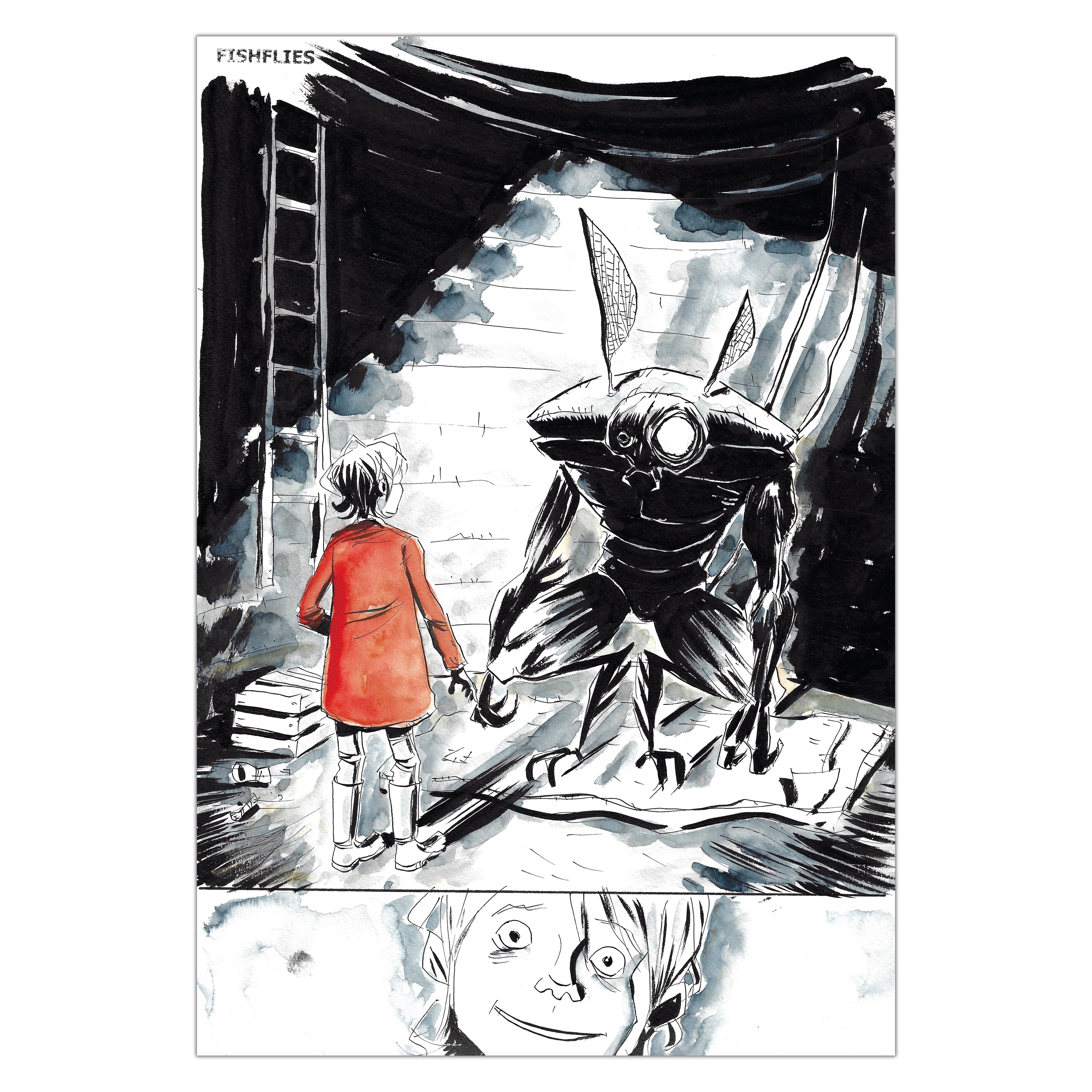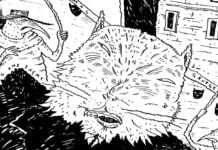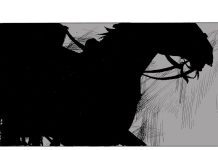10,000 Ink Stains: A Memoir
Cartoonist: Jeff Lemire
Publisher: Dark Horse Comics
Publication Date: July 2025
Jeff Lemire is a name that will need no introduction to most regular comics readers, be it fans of independent comics or major publishers. Over his twenty-five years in the industry, the Canadian writer / artist has become renowned for independent titles such as Essex County, Royal City and Minor Arcana, as well as big-two series such as Animal Man, Moon Knight and Sweet Tooth as well as his very own superhero universe, Black Hammer. Lemire, always a relatively private individual, dives into his life and career in his brand new memoir, 10000 Ink Stains, which looks honestly at his own experiences in the comics business, some of the incredible highs and crushing lows, and is a wonderfully intimate look at the experience of being a major name in the comics profession.
10000 Ink Stains is in mostly chronological order, beginning with Lemire’s youth and his first ever self-published collection of comics, Ashtray #1, and continuing all the way up to the present day and his work on Minor Arcana, the memoir is effectively a collection of essays and autobiographical writings, some published previously on his Substack, with process materials and behind-the-scenes artwork never before published. The most rewarding way to experience this book is to take breaks between chapters, potentially revisit some of the moments and works that Lemire is discussing in them with a new pair of eyes, and make sure you know at least a little about the comics he has made. Lemire’s love of comics is apparent in every page, and he states in the memoir:
I fell in love with comics when I was six years old and they have been a huge part of my life ever since.
Lemire discusses his youth and life before comics with a refreshing level of honesty and transparency. Over the decades, he has been repeatedly asked about the seemingly autobiographical elements of his work, and he finally breaks that down in detail here, discussing his life growing up in rural Canada and his experiences after moving to Toronto as a young adult. I found it incredibly moving and refreshing that he was honest about experiences with mental illness, alcoholism, and being caught in a difficult cycle of constant work to very little results. This section very much tackles the idea of the ‘starving artist’, with Lemire exploring some of the harm that idea does on young creatives and how his work was only able to flourish once he was in a stable position emotionally, looking after himself and escaping the cycle of desperation. Whilst these sections aren’t as detailed as say, Grant Morrison‘s Supergods, it’s still great to see someone discuss the experience of breaking into comics with honesty and respect for their audience. Lemire acknowledges his luck, but also how much pain and work it took to get even his earliest books published. Even then, it wasn’t an easy process, and it’s interesting to see a personal experience and perspective on it.

The vast majority of 10000 Ink Stains goes project by project into the various series and graphic novels that Lemire both writes and illustrates himself. There are many reasons for this, but the main one is that Lemire can go more into detail on his creative process when he does both the writing and the art, as opposed to just scripting. Every book, from lesser known titles such as The Nobody or Trillium, all the way to famous successes such as Sweet Tooth, is explored in detail. Lemire goes into his creative decisions, motivations for taking on or abandoning certain projects, and the process of creating each and every book. It’s incredibly enlightening, as you get to learn more about his creative process and how it’s evolved over his career. For every work of his that is deeply real and autobiographical, there is another that comes from a place of pure imagination and fiction. Lemire goes into as much detail about publishing deals and that process as he can, discussing and exploring how it felt to be ‘discovered’ by comics publishers and his initial success with Essex County. It’s interesting that Lemire often goes back to ideas or story concepts years after they first enter his mind, which means every ‘dropped’ project discusses in this book very much feels like something Lemire might return to further down the line. It’s never written in such a way that it is obtuse to those who haven’t read every book, and never goes into heavy spoilers. There are some things on here that I’ve not read, but it was still interesting to see how Lemire discusses them and his process for them, and it definitely made me want to read them more. I think Lemire almost knows that not everyone reading will like all of his work, but he wears that on his sleeve, and doesn’t seem desperate to impress.
I know my art style is hit or miss with people. You either love it or just don’t get it at all. I came to peace with that a long time ago. I can’t draw like Jim Lee or Bryan Hitch. I can only draw like Jeff Lemire, and I am more than okay with that.
I think Lemire knows a lot of people first discovered him through his superhero work, and he does dive into it here, with a deeply respectable level of candor, particularly towards his tumlutous time at Marvel Comics. It’s great to see a creator be so honest about some of the editorial madness behind the scenes at major companies, and while Lemire does not come off as bitter or hurt, he’s also human and you can feel his frustration at some of those experiences. It also demonstrates some of the massive changes in the industry over the last two decades, as superheroes have become a global phenomenon and both ‘big two’ publishers are owned by multi-billion dollar companies with a vested interest in protecting their brands. Make no mistake, these chapters aren’t joyless – Lemire is a comics fan just like the rest of us, and his passion for certain characters and heroes is palpable and infectious, so hearing about his experiences writing for them is fantastic. As someone who loves his Animal Man run deeply, I’m so glad that book got some time in the sun here. Lemire then goes into detail on his writing experiences for creator-owned books, such as Descender, Gideon Falls and Black Hammer. There are a lot of books there, and he doesn’t get to spend too much time on every one, which might be dissapointing to some, but his analysis and discussion of them is still interesting and full of insights, particularly on how his writing experiences differ from collaborator to collaborator.

The final third of the book focuses on Lemire’s experiences of getting older, returning to illustrating his own work, and his career expanding to work outside of graphic novels. This was my favorite part of the book – it was incredible to see an artist and creator reflecting on their current career, and where they want to go next, as opposed to reading about their thoughts once their career has already effectively ended. Lemire engages with some of the challenges to creating Roughneck, as well as The Secret Path with Gord Downie before his passing. The latter leads to one of the most moving moments in the book, a discussion of grief and creating long-lasting, important art that is genuinely trying to make a difference – and how to do more of that while you still have time to do so. It was interesting to hear Lemire’s thoughts on Royal City and Mazebook as well, and how at this point he still wants to challenge himself and his process and try out new things every time. Lemire isn’t one to rest on his laurels, and stands out as one of the hardest working people in the comics industry – as a writer myself, it was wonderfully resonant to hear some of his advice on how to keep yourself engaged with your art and how to continue to find motivation even when you’ve accomplished your initial goals. It was also interesting to hear Lemire discuss how mental illness still impacts him and his life; too often do people ignore it in favour of their success, and Lemire’s honesty on the topic might motivate other creators in the space to do the same.
Lemire also explores his experiences adapting his work for television, namely Sweet Tooth and Essex County. Both sections are brilliant reads, giving a lot of insight into the television and film industries and how they interact with the comics they are basing their work on. Lemire’s honest, complicated thoughts on the Sweet Tooth show are a great demonstration of his commitment to making an authentic memoir, as well as his stress and joy as the main showrunner for the Essex County miniseries. Many major comics professionals make the jump to working in film or television, with more and more seemingly attempting to do so to various degrees of success, and Lemire’s personal experiences are fascinating looks at what that experience is like, for better or worse. In general, 10000 Ink Stains functions as a memoir that demystifies the creative process, similarly to David Lynch‘s Catching The Big Fish, which makes it in my mind an essential read for amateur artists, writers and creatives.

It should be noted that 10000 Ink Stains isn’t really a comic or graphic novel in the traditional sense. The vast majority of it is non-fiction prose, accompanied by images of artwork, production materials or photos from Lemire’s life. The only ‘comic’ you really get in the book is the entirety of Lemire’s first ever self-published collection, Ashtray #1, printed here in full for the first time since its initial run. Whilst some might argue that an autobiographical comic format similar to Craig Thompson’s Ginseng Roots or Alison Bechdel’s Spent might have worked better for a project like this, I believe the prose format works in the book’s favour, allowing it time and space to explore every individual phase of Lemire’s life in detail, on his own terms. Lemire is, to no surprise, a great and entertaining writer, and the book is dense but easy to read. I think it’s best to allow yourself to stew and sit on it for a little while, if you can, and really let it wash over you as you immese yourself in the story of a life and a career.
Overall, 10000 Ink Stains is an essential read for fans of Lemire’s work and career, exploring his experiences in the comics industry over the last two decades with a refreshing level of honesty and respect for his audience. It’s an intimate look at one person’s creative process, how that’s evolved over the years, and how that change has informed his work and its evolution. I could have happily read another 200 pages with Lemire getting into every detail, no matter how big or small, because I found it to be an illuminating exploration of how to make comics that are true to yourself. Even for those who aren’t as familiar with Lemire and his work, it’s a great read, demystifying the process of making comics and the experience of being a professional in the comics business. The ultimate goal of this book is to show people that anyone, no matter where they come from or what they’ve been through, can make comics that mean something, to themselves and to others. As Lemire himself says:
If you’ve ever thought about making comics yourself, do it. Pick up a pen or pencil and start.
10,000 Ink Stains is out this month
Read more great reviews from The Beat!












